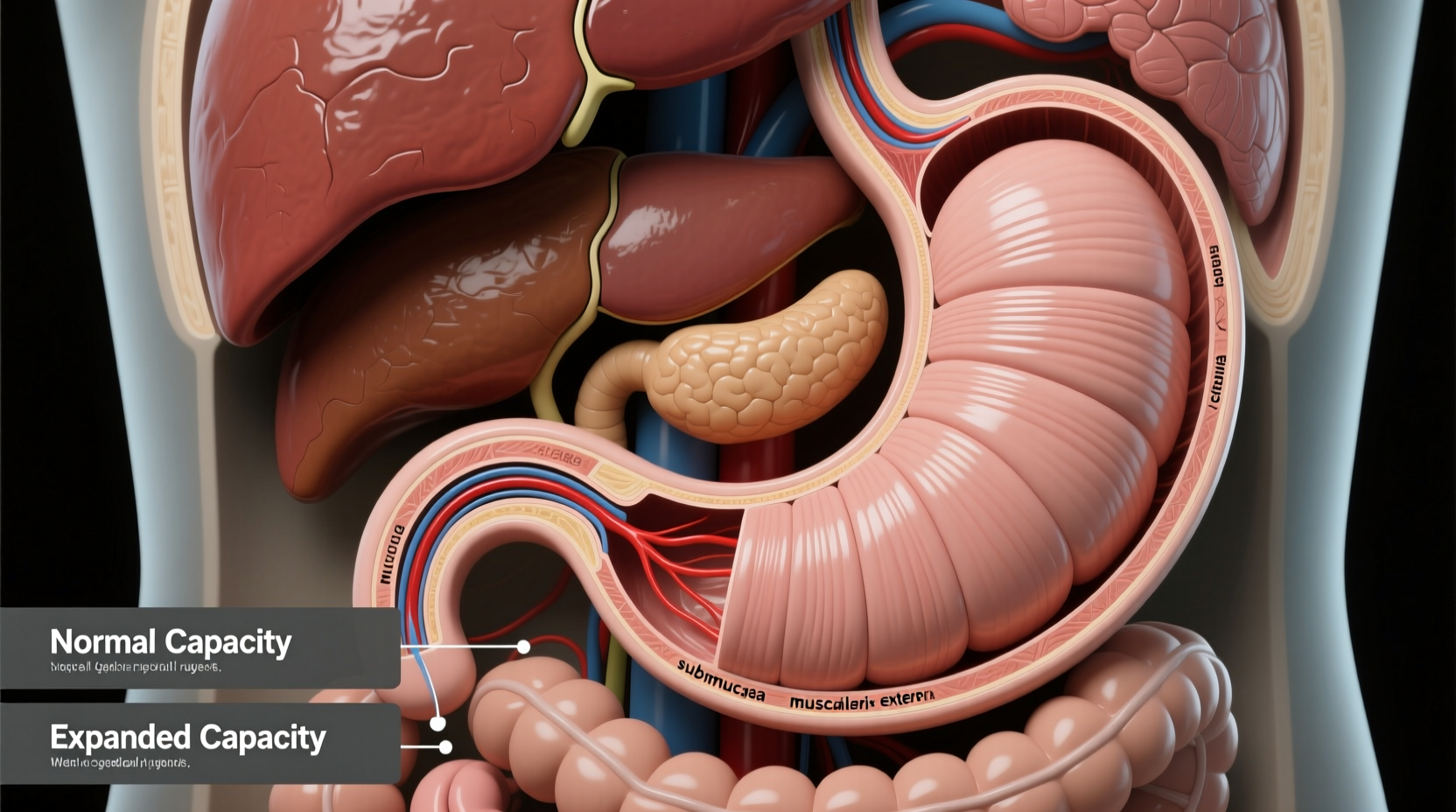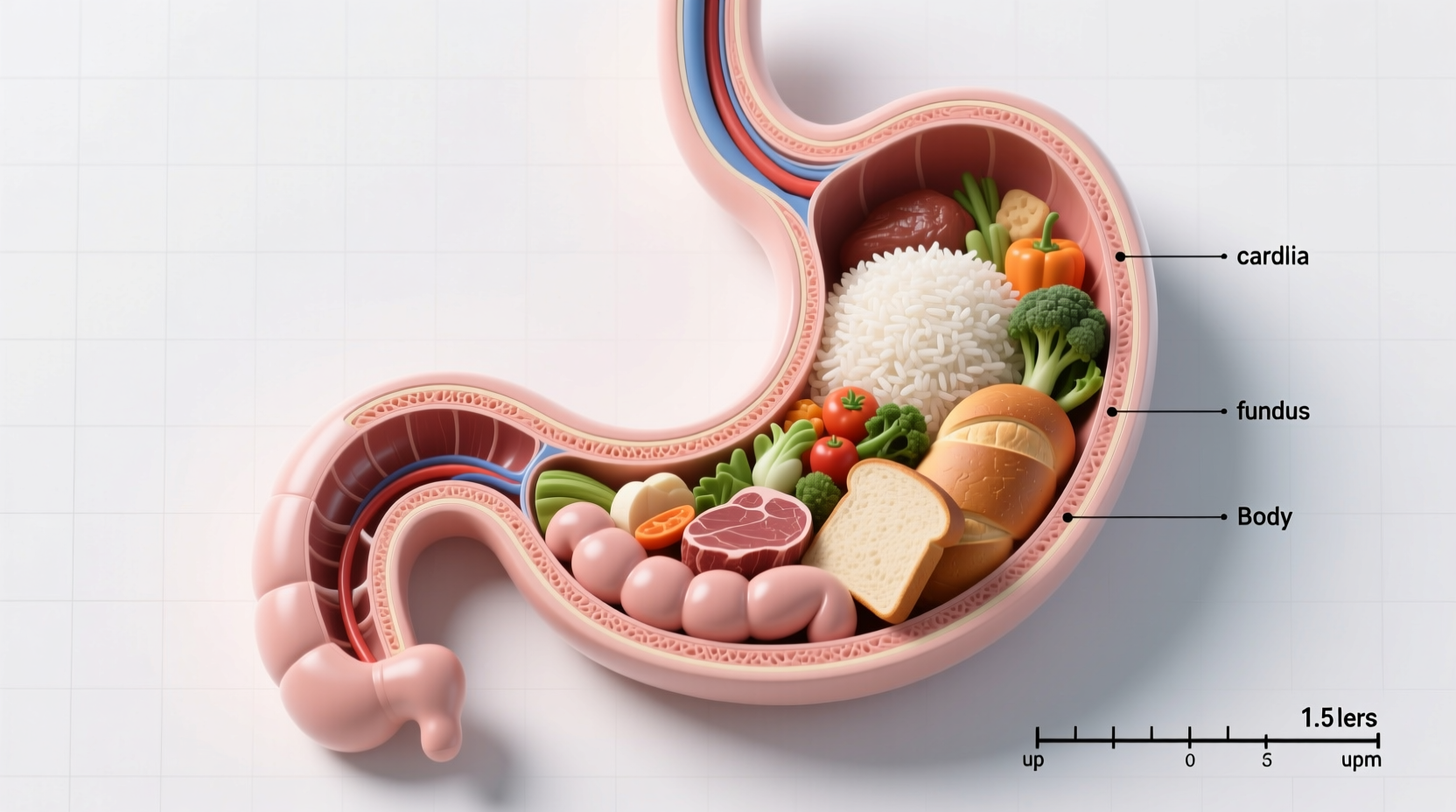The average adult stomach can comfortably hold about 1 to 1.5 liters (34-50 ounces) of food and liquid during a typical meal. While it can stretch to accommodate up to 4 liters (1.06 gallons) in extreme cases, this level of distension is dangerous and can lead to serious health complications.
Understanding Your Stomach's Capacity: More Than Just a Storage Tank
Have you ever wondered why you feel uncomfortably full after a large holiday meal? Or how competitive eaters manage to consume extraordinary amounts of food? The answer lies in your stomach's remarkable yet limited capacity. Understanding exactly how much food your stomach can hold isn't just interesting trivia—it's crucial information for maintaining healthy eating habits and recognizing potential digestive issues.
Stomach Physiology 101: How Your Digestive Storage Works
Your stomach isn't a rigid container but a highly elastic muscular organ designed to expand and contract. When empty, it holds approximately 50-100 milliliters (about 2 ounces), roughly the size of a small fist. As you eat, specialized stretch receptors in the stomach wall send signals to your brain, creating that familiar feeling of fullness.
These stretch receptors typically trigger satiety signals when your stomach reaches about 1 liter (34 ounces) of content. This biological mechanism helps prevent dangerous overfilling under normal circumstances.
| Stomach State | Capacity | Physical Comparison |
|---|---|---|
| Empty | 50-100 ml (2 oz) | Small fist |
| Normal meal | 1-1.5 L (34-50 oz) | Large grapefruit |
| Maximum safe capacity | 2-3 L (67-101 oz) | Small melon |
| Dangerous overfilling | 4+ L (106+ oz) | Large cantaloupe |
The Science Behind Stomach Expansion: What Happens When You Eat
Understanding how your stomach accommodates food involves recognizing its dynamic expansion process. When you begin eating, your stomach undergoes receptive relaxation—a neurological process that allows it to expand without increasing pressure. This clever mechanism enables comfortable food intake without triggering immediate discomfort.
As documented in NIH research on gastrointestinal physiology, the stomach's capacity varies based on several factors:
- Individual physiology: Stomach size naturally varies between people
- Eating patterns: Regular overeating can stretch stomach capacity over time
- Food composition: Liquids pass through faster than solids
- Age: Stomach elasticity decreases with age
- Previous surgeries: Medical procedures can alter stomach capacity
How Much Is Too Much? Recognizing Dangerous Limits
While your stomach can technically stretch to hold up to 4 liters (1.06 gallons) of content, this represents a medical emergency. Competitive eaters who consume extraordinary amounts—like the 10,000-calorie meals sometimes featured in media—train their stomachs to expand beyond normal limits, but this practice carries significant health risks.
According to Mayo Clinic guidelines, consistently overfilling your stomach can lead to:
- Gastroparesis (delayed stomach emptying)
- Chronic acid reflux
- Reduced sensitivity to fullness signals
- Increased risk of obesity
- Potential stomach rupture in extreme cases

Can Your Stomach Size Change Permanently?
Many people wonder if their stomach can actually shrink after dieting or expand from overeating. Research from National Institute of Diabetes and Digestive and Kidney Diseases shows that while the stomach's physical size remains relatively constant, your perception of fullness can change.
When you consistently eat large portions, your stretch receptors adapt, requiring more food to trigger the same fullness signals. Conversely, reducing portion sizes over several weeks can help reset these signals, making you feel satisfied with less food—a valuable insight for those managing weight.
Practical Tips for Healthy Eating Within Your Natural Capacity
Understanding your stomach's natural limits can transform your relationship with food. Here are evidence-based strategies to work with your body's natural signaling system:
- Practice mindful eating: Chew slowly (aim for 20-30 chews per bite) to give fullness signals time to register
- Use smaller plates: Visual cues help prevent overfilling your stomach
- Start meals with water: Drinking 16 ounces before eating can help reduce overall intake
- Include protein and fiber: These nutrients increase satiety at lower volumes
- Wait 20 minutes before seconds: Fullness signals take time to reach your brain
Remember that feeling comfortably full is different from feeling stuffed. Your goal should be satisfaction, not maximum capacity utilization. As CDC nutrition guidelines emphasize, appropriate portion control supports long-term digestive health and weight management.
When to Consult a Healthcare Professional
While occasional overeating happens to everyone, certain symptoms warrant medical attention:
- Persistent feeling of fullness after small meals
- Unintentional weight loss with normal eating
- Severe abdominal pain after eating
- Chronic nausea or vomiting
- Difficulty swallowing
These could indicate underlying conditions like gastroparesis, stomach tumors, or other digestive disorders that require professional evaluation.
Frequently Asked Questions
How much food can the average stomach hold during a normal meal?
The average adult stomach comfortably holds 1 to 1.5 liters (34-50 ounces) during a typical meal. This capacity allows for proper digestion while triggering natural fullness signals that prevent overeating.
Can your stomach actually shrink if you eat less?
Your stomach's physical size doesn't significantly change, but your perception of fullness can adjust. After consistently eating smaller portions for 3-4 weeks, your stretch receptors become more sensitive, making you feel satisfied with less food.
What happens if you consistently overfill your stomach?
Regularly exceeding your stomach's natural capacity can lead to reduced sensitivity to fullness signals, chronic acid reflux, gastroparesis, and increased risk of weight gain. The stomach can stretch temporarily but doesn't return to optimal signaling function immediately.
How long does it take for the stomach to empty after a meal?
Stomach emptying time varies by meal composition. Liquids typically pass through in 10-20 minutes, while a balanced meal takes 2-4 hours. High-fat or high-protein meals may take up to 6 hours to fully empty from the stomach into the small intestine.
Can stomach capacity be measured medically?
Yes, medical professionals can measure stomach capacity through gastric emptying studies, barium X-rays, or gastric scintigraphy. These tests track how quickly food leaves the stomach and can identify abnormalities in stomach function or capacity.











 浙公网安备
33010002000092号
浙公网安备
33010002000092号 浙B2-20120091-4
浙B2-20120091-4